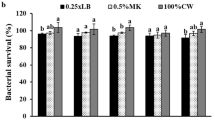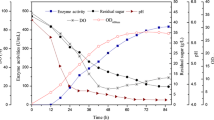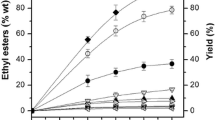Abstract
In this study, pumice stone (PS), which is a vastly available material in Turkey, was evaluated as an alternative immobilization material in comparison to other commercially available immobilization materials such as glass beads and polyurethane foam. All immobilized bioreactors resulted in much better 1,3-propanediol production from waste glycerol in comparison to the suspended cell culture bioreactor. It was also demonstrated that the locally available PS material is as good as the commercially available immobilization material. The maximum volumetric productivity (8.5 g L−1 h−1) was obtained by the PS material, which is 220 % higher than the suspended cell system. Furthermore, the immobilized bioreactor system was much more robust against cell washout even at very low hydraulic retention time values.











Similar content being viewed by others
References
Mu, Y., Teng, H., Zhang, D. J., Wang, W., & Xiu, Z. L. (2006). Microbial production of 1,3-propanediol by Klebsiella pneumoniae using crude glycerol from biodiesel preparations. Biotechnology Letters, 28(21), 1755–1759.
Taconi, K. A., Venkataramanan, K. P., & Johnson, D. T. (2009). Growth and solvent production by Clostridium pasteurianum ATCC (R) 6013 (TM) utilizing biodiesel-derived crude glycerol as the sole carbon source. Environmental Progress Sustainable, 28(1), 100–110.
Jun, S. A., Moon, C., Kang, C. H., Kong, S. W., Sang, B. I., & Um, Y. (2010). Microbial fed-batch production of 1,3-propanediol using raw glycerol with suspended and immobilized Klebsiella pneumoniae. Applied Biochemistry and Biotechnology, 161(1–8), 491–501.
Mu, Y., Xiu, Z. L., & Zhang, D. J. (2008). A combined bioprocess of biodiesel production by lipase with microbial production of 1,3-propanediol by Klebsiella pneumoniae. Biochemical Engineering Journal, 40(3), 537–541.
Xu, Y. Z., Liu, H. J., Du, W., Sun, Y., Ou, X. J., & Liu, D. H. (2009). Integrated production for biodiesel and 1,3-propanediol with lipase-catalyzed transesterification and fermentation. Biotechnology Letters, 31(9), 1335–1341.
Amaral, P. F. F., Ferreira, T. F., Fontes, G. C., & Coelho, M. A. Z. (2009). Glycerol valorization: new biotechnological routes. Food Bioproducts Process, 87(C3), 179–186.
Zeng, A. P., & Biebl, H. (2002). Bulk chemicals from biotechnology: the case of 1,3-propanediol production and the new trends. Advances in Biochemical Engineering/Biotechnology, 74, 239–259.
Johannes, T., Simurdiak, M. R., & Zhao, H. (2006). Biocatalysis. In S. Lee (Ed.), Encyclopedia of chemical processing. New York: Taylor & Francis.
Cho, M. H., Joen, S. I., Pyo, S. H., Mun, S., & Kim, J. H. (2006). A novel separation and purification process for 1,3-propanediol. Process Biochemistry, 41(3), 739–744.
Hao, J., Xu, F., Liu, H. J., & Liu, D. H. (2006). Downstream processing of 1,3-propanediol fermentation broth. Journal of Chemical Technology and Biotechnology, 81(1), 102–108.
Patwardhan, P. R., & Srivastava, A. K. (2004). Model-based fed-batch cultivation of R. eutropha for enhanced biopolymer production. Biochemical Engineering Journal, 20(1), 21–28.
Wang, Y. H., Teng, H., & Xiu, Z. L. (2011). Effect of aeration strategy on the metabolic flux of Klebsiella pneumoniae producing 1,3-propanediol in continuous cultures at different glycerol concentrations. Journal of Industrial Microbiology and Biotechnology, 38(6), 705–715.
Bizukojc, M., Dietz, D., Sun, J., & Zeng, A. P. (2010). Metabolic modelling of syntrophic-like growth of a 1,3-propanediol producer, Clostridium butyricum, and a methanogenic archeon, Methanosarcina mazei, under anaerobic conditions. Bioprocess and Biosystems Engineering, 33(4), 507–523.
Zheng, Z. M., Cheng, K. K., Hu, Q. L., Liu, H. J., Guo, N. N., & Liu, D. H. (2008). Effect of culture conditions on 3-hydroxypropionaldehyde detoxification in 1,3-propanediol fermentation by Klebsiella pneumoniae. Biochemical Engineering Journal, 39(2), 305–310.
Zhu, J. G., Li, S., Ji, X. J., Huang, H., & Hu, N. (2009). Enhanced 1,3-propanediol production in recombinant Klebsiella pneumoniae carrying the gene yqhD encoding 1,3-propanediol oxidoreductase isoenzyme. World Journal of Microbiology and Biotechnology, 25(7), 1217–1223.
Saxena, R. K., Anand, P., Saran, S., & Isar, J. (2009). Microbial production of 1,3-propanediol: recent developments and emerging opportunities. Biotechnology Advances, 27(6), 895–913.
Gungormusler, M., Gonen, C., & Azbar, N. (2011). Continuous production of 1,3-propanediol using raw glycerol with immobilized Clostridium beijerinckii NRRL B-593 in comparison to suspended culture. Bioprocess and Biosystems Engineering, 34(6), 727–733.
Gungormusler, M., Gonen, C., Ozdemir, G., & Azbar, N. (2010). Fermentation medium optimization for 1,3-propanediol production using Taguchi and Box–Behnken experimental designs. Fresenius Environmental Bulletin, 19(12), 2840–2847.
Xiu, Z. L., Song, B. H., Wang, Z. T., Sun, L. H., Feng, E. M., & Zeng, A. P. (2004). Optimization of dissimilation of glycerol to 1,3-propanediol by Klebsiella pneumoniae in one- and two-stage anaerobic cultures. Biochemical Engineering Journal, 19(3), 189–197.
Villegas, C. G., Santos, V. E., Zazo, M., Garcia, J. L., & Garcia-Ochoa, F. (2007). Fermentation of glycerol to 1,3-propanediol by Klebsiella oxytoca NRTL B-199: study of product inhibition. Journal of Biotechnology, 131(2), S102–S102.
Biebl, H., Zeng, A. P., Menzel, K., & Deckwer, W. D. (1998). Fermentation of glycerol to 1,3-propanediol and 2,3-butanediol by Klebsiella pneumoniae. Applied Microbiology and Biotechnology, 50(1), 24-29.
Zhang, G. L., Ma, B. B., Xu, X. L., Li, C., & Wang, L. W. (2007). Fast conversion of glycerol to 1,3-propanediol by a new strain of Klebsiella pneumoniae. Biochemical Engineering Journal, 37(3), 256–260.
Cheng, K. K., Liu, D. H., Sun, Y., & Liu, W. B. (2004). 1,3-Propanediol production by Klebsiella pneumoniae under different aeration strategies. Biotechnology Letters, 26(11), 911–915.
Cheng, K. K., Liu, H. J., & Liu, D. H. (2005). Multiple growth inhibition of Klebsiella pneumoniae in 1,3-propanediol fermentation. Biotechnology Letters, 27(1), 19–22.
Zeng, A. P., Ross, A., Biebl, H., Tag, C., Gunzel, B., & Deckwer, W. D. (1994). Multiple product inhibition and growth modeling of Clostridium–Butyricum and Klebsiella–Pneumoniae in glycerol fermentation. Biotechnology and Bioengineering, 44(8), 902–911.
Menzel, K., Ahrens, K., Zeng, A. P., & Deckwer, W. D. (1998). Kinetic, dynamic, and pathway studies of glycerol metabolism by Klebsiella pneumoniae in anaerobic continuous culture: IV. Enzymes and fluxes of pyruvate metabolism. Biotechnology and Bioengineering, 60(5), 617–626.
Zheng, Z. M., Hu, Q. I., Hao, J., Xu, F., Guo, N. N., Sun, Y., et al. (2008). Statistical optimization of culture conditions for 1,3-propanediol by Klebsiella pneumoniae AC 15 via central composite design. Bioresource Technology, 99(5), 1052–1056.
Riondet, C., Cachon, R., Wache, Y., Alcaraz, G., & Divies, C. (1999). Changes in the proton-motive force in Escherichia coli in response to external oxidoreduction potential. European Journal of Biochemistry, 262(2), 595–599.
Riondet, C., Cachon, R., Wache, Y., Alcaraz, G., & Divies, C. (2000). Extracellular oxidoreduction potential modifies carbon and electron flow in Escherichia coli. Journal of Bacteriology, 182(3), 620–626.
Acknowledgment
The authors wish to thank TUBITAK-CAYDAG under grant no. 109Y150 for the financial support of this study. The data presented in this article were produced within the projects above; however, only the authors of this article are responsible for the results and discussions made herein.
Author information
Authors and Affiliations
Corresponding author
Rights and permissions
About this article
Cite this article
Gonen, C., Gungormusler, M. & Azbar, N. Comparative Evaluation of Pumice Stone as an Alternative Immobilization Material for 1,3-Propanediol Production from Waste Glycerol by Immobilized Klebsiella pneumoniae . Appl Biochem Biotechnol 168, 2136–2147 (2012). https://doi.org/10.1007/s12010-012-9923-1
Received:
Accepted:
Published:
Issue Date:
DOI: https://doi.org/10.1007/s12010-012-9923-1




